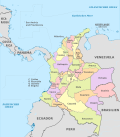Nariño Department
You can help expand this article with text translated from the corresponding article in Spanish. (October 2012) Click [show] for important translation instructions.
|
Department of Nariño
Departamento de Nariño | |
|---|---|
 View of Las Lajas Sanctuary | |
| Motto(s): Desde el mar hasta el Galeras (Spanish: From the sea to the Galeras) | |
| Anthem: Himno del Departamento de Nariño | |
 Nariño shown in red | |
 Topography of the department | |
| Coordinates: 01°10′N 77°16′W / 1.167°N 77.267°W | |
| Country | |
| Region | Pacific Region/Andean Region |
| Established | 6 August 1904 |
| Capital | Pasto |
| Government | |
| • Governor | Luis Alfonso Escobar (2024-2027) (Historic Pact for Colombia) |
| Area | |
• Total | 33,268 km2 (12,845 sq mi) |
| • Rank | 11th |
| Population (2018)[1] | |
• Total | 1,630,592 |
| • Rank | 8th |
| • Density | 49/km2 (130/sq mi) |
| GDP | |
| • Total | COP 21,775 billion (US$ 5.1 billion) |
| Time zone | UTC-05 |
| ISO 3166 code | CO-NAR |
| Subregions | 13 |
| Municipalities | 64 |
| HDI (2019) | 0.724[3] high · 24th of 33 |
| Website | [Gobernación http://xn--nario-rta.gov.co/inicio/] |
Nariño (Spanish pronunciation: [naˈɾiɲo]) is a department of Colombia named after independence leader Antonio Nariño. Its capital is Pasto. It is in the west of the country, bordering Ecuador and the Pacific Ocean.
Nariño has a diverse geography and varied climate according to altitude: hot in the plains of the Pacific and cold in the mountains, where most of the population resides, a situation that is repeated in a north-south direction. Other important cities include Tumaco and Ipiales.
History
[edit]| Year | Pop. | ±% |
|---|---|---|
| 1973 | 809,178 | — |
| 1985 | 1,085,173 | +34.1% |
| 1993 | 1,443,671 | +33.0% |
| 2005 | 1,541,956 | +6.8% |
| 2018 | 1,630,592 | +5.7% |
| Source:[4] | ||
The territory was occupied during the Pre-Columbian era by numerous Indian tribes, including Quillacingas, Awá, Pasto, and Tumas. The first European conquistador who entered the territory was Andagoya Pascual in 1522, who traveled from the Colombian Pacific coast and then used information obtained by Francisco Pizarro to organize the expedition that culminated in the conquest of Peru.
Juan de Ampudia and Pedro de Añazco first explored the mountainous part of the department, commissioned by Sebastián de Belalcázar in 1535, who then toured the territory in 1536 and reached Popayán and remained for some time before leaving for Spain.
Major Municipalities
[edit]Municipal population position
[edit]According to the latest census conducted in 2018; 1,335,521 people live in Nariño.
The city of Pasto and the municipalities of Chachagüí, Nariño, Tangua, Chía, Madrid and Yacuanquer form a single metropolitan area.
| Rank | City or municipality | Inhabitants (2018)* | ||||
|---|---|---|---|---|---|---|
| 1 | San Juan de Pasto | 352,326 | ||||
| 2 | Tumaco | 138,091 | ||||
| 3 | Ipiales | 105,517 | ||||
| 4 | Túquerres | 42,413 | ||||
| 5 | Barbacoas | 34,248 | ||||
| 6 | Cumbal | 32,672 | ||||
| 7 | La Unión | 28,659 | ||||
| 8 | Samaniego | 23,727 | ||||
| 9 | Olaya Herrera | 21,415 | ||||
| 10 | Magüí Payán | 18,262 | ||||
| Source: DANE *projection[5] | ||||||
Administrative divisions
[edit]
Nariño is composed of thirteen subregions and 64 municipalities organized among them:
- Centro: Pasto, Chachagüí, La Florida, Nariño, Tangua and Yacuanquer.
- Guambuyaco: El Peñol, El Tambo, La Llanada and Los Andes.
- Juanambú: Arboleda, Buesaco, La Unión, San Pedro de Cartago and San Lorenzo.
- La Cordillera: Cumbitara, El Rosario, Leiva, Policarpa and Taminango.
- La Sabana: Guaitarilla, Imués, Ospina, Sapuyes and Túquerres.
- Los Abades: Providencia, Samaniego and Santa Cruz.
- Obando: Aldana, Contadero, Córdoba, Cuaspud, Cumbal, Funes, Guachucal, Gualmatán, Iles, Ipiales, Potosí, Puerres and Pupiales.
- Occidente: Ancuya, Consaca, Linares and Sandona.
- Pacífico Sur: Francisco Pizarro and Tumaco.
- Piedemonte Costero: Mallama and Ricaurte.
- Río Mayo: Belén, Colón, El Tablón, La Cruz, San Bernardo, San José de Albán and San Pablo.
- Sanquianga: El Charco, La Tola, Mosquera, Olaya Herrera and Santa Bárbara.
- Telembí: Barbacoas, Magüí Payán and Roberto Payán.
See also
[edit]References
[edit]- ^ "Proyecciones y retroproyecciones de población departamental (1985-2019 y 2020-2050) - CNPV 2018". DANE. 22 de marzo de 2023. Retrieved 15 de abril de 2025.
{{cite web}}: Check date values in:|access-date=and|date=(help) - ^ "Producto Interno Bruto por departamento", www.dane.gov.co
- ^ "Sub-national HDI - Area Database - Global Data Lab". hdi.globaldatalab.org. Retrieved 13 September 2018.
- ^ "Reloj de Población". DANE. Departamento Administrativo Nacional de Estadísitica. Archived from the original on 16 January 2018. Retrieved 6 July 2017.
- ^ Projections 1985-2020. Bogotá: DANE. 12 May 2011. Archived from the original on 25 December 2018. Retrieved 30 July 2015.
External links
[edit]- (in Spanish) Government of Narino official website



